
The Greenfield Family Website
The life and Times of:
Francis Willard Greenfield (Frank)
Adventurer - Musician - Inventor - Soldier - Pilot - Loving Husband - Father
Grandfather - Business man - and friend to all.
and Marjorie Grace Greenfield
Beloved Daughter - Sister - Devoted Wife - Mother - Grandmother
Business Woman - Cook extraordinaire - and loyal friend.
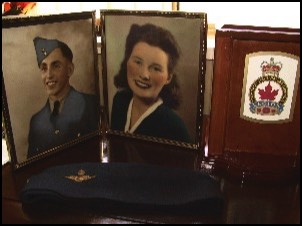
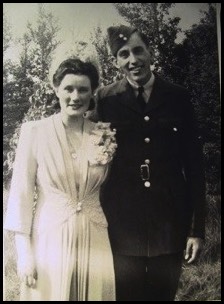
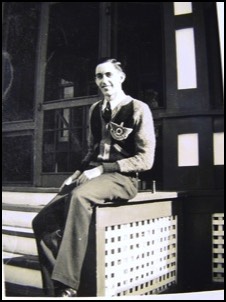

By 1918 World War One had just been won and Canada was recovering from a great loss of men and resources. The following year as the Northwest Mounted Police were being re-formed into the Royal Canadian Mounted Police service, Frank and Marjorie were born on their Saskatchewan farms.
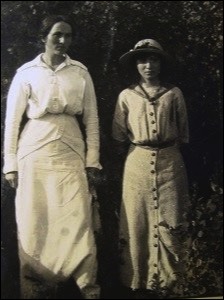
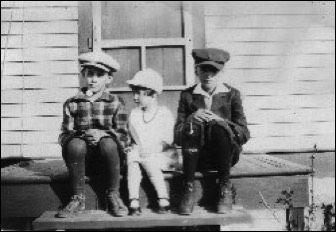
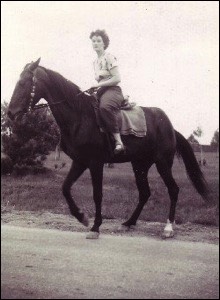
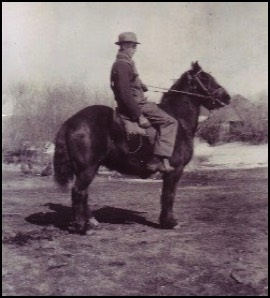
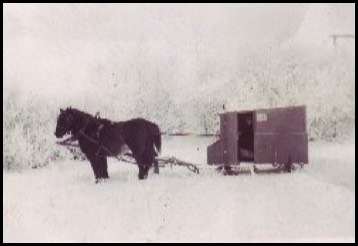
Frank & Vern's traveling music van 1937
By today’s standards, life in those days appeared to be much harder, but no one complained because at the time this was considered normal. In fact, Ewert and his brothers went to work in the dusty fields each day wearing a jacket and tie. (Talk about dressing for success!) The life and times in and around Gibbs and Govan Saskatchewan and the pioneer stories of that era have been told and retold in numerous books, eloquently described by this generation.
Image Right: Farm girl Marjorie
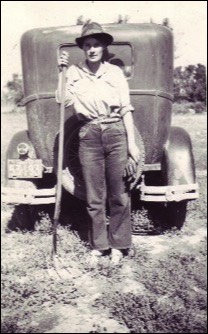
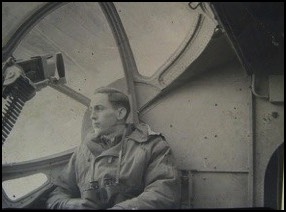
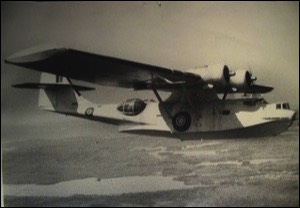
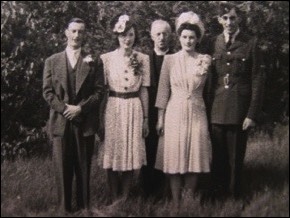
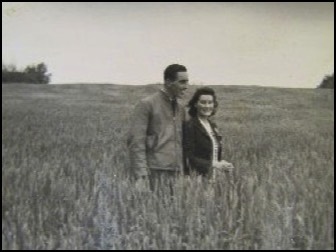
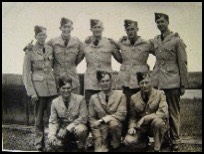
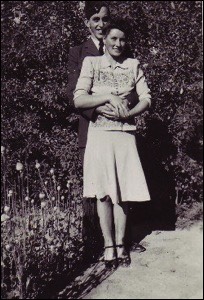
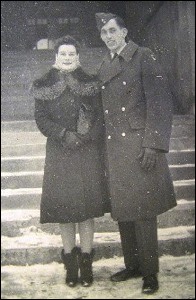
This was indeed a time of great anticipation! A world war had just been won, and mankind for the moment seemed to be free of impending evil. From the onset of the Great Depression until the winning of World War II, Canadians had known little more than fleeting hope and hardship. This had been an era of scant prosperity and the whole country suffered because of it. The war had employed most of the young men and women in their prime, those who would be the next generation of business owners and homemakers. Canada’s slim coffers had been used to fund the war effort rather than building essential roads and facilities needed to develop the Canadian northwest. Now, hundreds of war veterans were streaming back home from their stations across Canada and overseas, full of excitement, hoping to build a new life.
In those years, the narrow dirt road from Edmonton northward meandered through miles of unclaimed forest, across the river at Athabasca and through the bogs along Lesser Slave Lake. Despite the remoteness of the land and what might seem to be discouraging circumstances along the way, the Greenfield’s were sustained by their hopes and dreams.
The economy was growing and there were great opportunities just waiting to be discovered in the North.
Frank had purchased a 1928 Dodge car in Calgary when he left the military service. This handy vehicle had now become their moving truck, loaded down, heading north. A Winnipeg Couch was roped across the front bumper and two large trunks were tied on the back bumper with all their worldly possessions crammed inside.
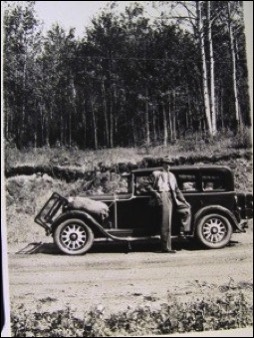
Frank with the 1928 Dodge moving to the Peace River Country
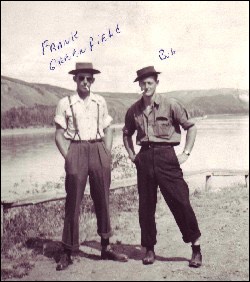
Frank with Bob Hampton crossing the Peace River.
Image compliments of Bev Paley
The land of the Mighty Peace is characterized by an immense span of rich, forested land brutally divided by deep river channels. It was some of this rugged land that was made available to surviving veterans as homestead land.
Those big rivers, though scenic to behold, became vast obstacles to ill-equipped settlers pushing their way into this Promised Land. The other great barrier was the sheer expanse of unrelenting bush! The thousands of hectares of aspens, birch, spruce and willow covering the land were, however, an indication of the wealth of the soil. Unfortunately, the expense of removing that bush to claim the land for agriculture was most often beyond the means of early settlers, so the Alberta Government embarked on a “project” to clear the land and render it accessible to the homesteaders.
One man was chosen to undertake this task and his name was O.B. Lassiter. Mr. Lassiter, already in his seventies, would soon command a small army of men and machines to tackle the enormous task of clearing 100,000 acres of bush land for agricultural use.
Arriving in the Peace Country at that time in history was opportune in that there was much work for those with youth and vision. Sawmills were turning out needed lumber for the building boom in the area, and thousands of acres of land were being cleared for farming. The Alaska Highway was still under construction and every hopeful community along the railroad was expanding.
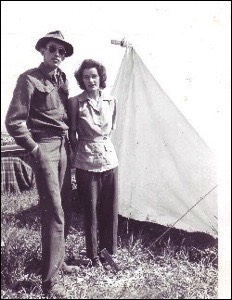
Frank & Marjorie living in a tent
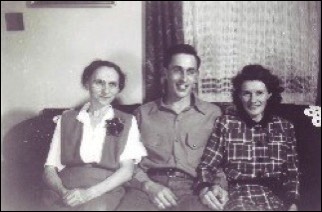
With Grandmother Etta in Edmonton
That first winter was, I’m sure, a cold one for these two lovebirds, living in a 12 ft. by 12 ft. canvas tent on the frozen ground and going to work each day at the sawmill. Let no one tell you that people cannot live on love and determination alone, because they did and flourished.
The following winter, wanting to move up in the world a little, they moved into a small building which had been Marjorie’s brother’s chicken house, only a couple of miles from the mill.
The next year they moved again, this time to the hamlet of Wanham, and again erected their tent home. Here, the bustling Lassiter clearing camp was established, with its large crews of ‘Cat skinners’ and support staff, daily stripping the land of unwanted forest.
Frank, who was a trained aero engineer, went to work that year operating a D8 Caterpillar tractor (Cat). These were good days in their youth, hard but fun, as they made new friends and shared the pioneering spirit with so many others. Frank worked 12-hour shifts on that belching old Cat, claiming the land for future farmers, while Marjorie worked long hours at the local restaurant.
They eventually purchased a little 12ft. by 20 ft. cabin from one of Lassiter’s crewmen. That one thousand dollar purchase was only a shack, but was to become home sweet home for many years to come.
The word “Project” in those days was of course an expression that referred to the Lassiter clearing project and it was this rugged area that would eventually become home to many a family. If ever there was a government make-work project, this was it!
The ‘Cats’ had been reclaimed from the Alaska Highway development and some from as far off as the Aleutian Islands. The maintenance and operations were manned with every available unemployed hopeful that could be found. Thus, the land was cleared and the great Peace Country farming block took shape.
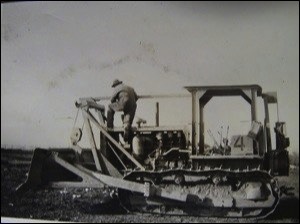
Frank on old # 4 Cat
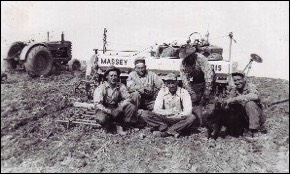
Don Morgan - Jerry Barry - Frank Greenfield - Armand Charest & Norman Barnhardt. First seeding of the new land
This little community of Eaglesham was reportedly named after a village in Scotland by the same name. It was a small rail-side village comprised mostly of farming settlers from across the country, and in fact from around the world. The buzzword across the nation at that time was “The Peace River Country.” This was toted as the land of opportunity for all, the mosquitoes not mentioned! Indeed, many people came to see.
Year by year, newcomers arrived, full of expectancy of what they might find in this highly acclaimed land, people of diverse nationality and culture from war-torn Europe to the Canadian north. Dutch, German, Ukrainian, Polish, Swedish, Scottish, Irish, English, French and a few Native Indians, to name some, were the men and women who settled and developed “Our Peace River Country.” In time, such distinctively different people as these became our neighbours and our friends. A grand cross-cultural experience such as this presented a rare educational element that would positively shape peoples’ attitude and worldview.
The summer of ‘49 was very busy, as the couple had relocated from Wanham to the community of Eaglesham in order to stay near the clearing project. The pungent smell of brush-burning smoke lingered across the land, and the community teemed with working men and women.
Frank was one of the many operators running Cat that spring, cutting trees, routing out stumps and piling the brush ready for burning. More than once, a Cat operator would tree a black bear and signal another Cat-skinner to come and push the tree over. This newly found sport helped to pass the weeks of monotony those men had to endure. Of course, being young and agile, I don’t suppose they ever considered the danger an angry wild black bear might actually present.
The operators also had to continually invent new ideas to keep awake during long shifts in the bush. The great danger would be that an unnoticed tree trunk might slide up over the cutter or through the brush piler and crush the operator in the cab of the Cat. Occasionally, one Cat would run up on the back of another with the operator sound asleep, a tactic that was sure to wake a man out of the sweetest dream. Since the government had yet to construct roads in the area, the workmen would often have to navigate back to base camp by the stars at night. It was prudent to learn which star was actually the “North Star.”
Frank tells the story of his friend Rex, who, while cutting brush, routed a sleepy black bear from his den. Rex, not wanting to be attacked by the disgruntled creature, attempted to crush it with the heavy steel cutter on the front of his Cat, but to his frustration the clever animal eluded him. Time and again, he lifted the cutter, repositioned the Cat and slammed it down again hoping to kill the bear. Operating nearby, Frank watched Rex’s futile antics with amusement. Finally, he signalled for Rex to lift his cutter as high as he could, then reposition the Cat, first this way, then that, and then slam the cutter down. Rex watched anxiously over the side of the noisy Cat as he slowly raised the equipment up again, but the crafty bear was nowhere in sight. Suddenly, Rex gave a yell and was seen bailing headlong over the back of his running machine! The frightened animal had become trapped between the Cat and the brush cutter, so that when the equipment was raised, the bear simply rode up on the yoke of the brush cutter and stepped off onto the engine hood. The first rule when operating a Cat is that “one” is comfortable, while “two” is very much a crowd!
One cold day, Frank was working alongside his friend Eddy, cutting and piling brush. While he was overturning tree stumps, Eddy accidentally killed a young black bear that had been frightened from its den. These two mischievous men who were always looking for fun decided to hide this bear in someone’s bed, back at camp. The poor unsuspecting fellow that “won” the bear prize was their friend Jerry Barry. Now, it was Jerry’s habit to stay out late, so when he came home “singing” late in the night, the lights were all out, but the mischief makers were still awake and watching. Jerry happily stripped down and slipped under the covers, but his sweet rest was only momentary. The men who were watching will testify that, with a scream of horror, Jerry virtually flew from the bed and out of the bunkhouse, reportedly in a single bound! I’m sure that the perpetrators spent the next several hours snickering over their dastardly prank! This became the joke of the winter for the Lassiter boys that year.
When it came to practical jokers, it seemed that no one in the free world was safe. These men were to strike again that year, and the next unsuspecting victim would be big Cliff Osterman. Cliff was Cat-skinning west along the Fox Creek, a long way from home. On this dark and overcast night, he became lost and missed his shift change back at camp. Now if his luck wasn’t already bad enough, guess who they sent to find him? You’ve got it, the pranksters Frank Greenfield and Eddy Trudel. Cliff had stopped along the banks of Fox Creek and had built a fire in front of his dozer blade in order to keep warm. Alone in the quiet of the wilderness, he relaxed and waited for daylight to arrive, unaware of the approaching danger. When his rescuers spotted the campfire in the distance they were barely able to believe their good fortune. Covering their flashlights with a cloth, the two men sneaked quietly up on the unsuspecting camper as he snoozed by the fire. What an opportunity! Out of the inky darkness, they rushed the campfire, growling fiercely, which sent Cliff screaming over backwards down into the ravine behind him. Only a large tree prevented him from descending the full three hundred feet down the bank and into the creek! With wide grins and flashlights uncovered, the two “jokers” now had a real rescue on their hands, as they clambered downhill after their frightened friend. The truth, of course, was that if they hadn’t “jumped” Cliff when he least expected it, the two jokers would not likely have succeeded. Cliff was a veritable mountain of a man and more than capable of defending himself in the face of danger.
The Lassiter crews worked day and night on those noisy, rough contraptions. The D8s were monster machines and virtually devoid of suspension, causing them to pound harshly over every log and frozen stump. The young men were hardy, strong and of high endurance, who, for only a dollar an hour, endured gruelling 12-hour shifts in the cold of winter and the heat of summer. They dutifully worked to cut down that immense forest and pile the brush to be burned. After the brush was cleared and burned, they employed those same Cats to pull enormous tillers that prepared the land for agriculture. The homesteader could then come in and begin finishing the fields with smaller equipment, some even drawn by horses.
With the bulk of the trees removed and the hardest part of the land broken up, the homesteader needed only to finish removing the tree roots that were still lurking in the soil, and cultivate the land.
Root picking, however, was a job that employed most families for years to come. Tree roots hidden in the soil would present any number of problems for the farmer, such as causing their cultivating equipment to leap out of the ground, or getting caught in harvesting machines. The tedious removal of this underground menace turned out to be a backbreaking and dirty job. Everyone became intimately familiar with the skill of “root picking” and wealthy was the homesteader who had many children to help with the work.
Although it was hard work, they all knew that it was a necessary step to develop the family farm. Everywhere one travelled in those days, you would find farms with rows and rows of these little root piles lining the fields. Once burned, these dirty piles would smolder away sometimes for days as the farmer attempted to eliminate them. This created a haze of pungent root pile smoke across the land, a smell that one can never forget.
Each half-section homestead was bordered with a 20-rod strip (about 100 meters) of bush down one side and across one end to protect the land from wind erosion. Most landowners would eventually remove this by hand, but at the time it served as a good windbreak and as a ready supply of firewood, berries and mushrooms. These little strips of bush also lessened the impact of civilization upon the wildlife in the area, giving them corridors of freedom. In this way, it also helped the early pioneers who depended upon this wild meat for survival.
Indeed, wildlife was in abundance in this newly claimed land, providing great hunting for pioneering youngsters whose job it was to keep the ‘larder’ supplied with fresh partridge or rabbits.
They were accustomed to seeing coyotes, wolves, porcupine and black bears, as they continually moved through the area. Moose and deer were plentiful as well, and co-existed with our domestic animals, sometimes on the same pastureland. There were even a few elk in the area, which were preferred as game because of their deliciously mild, lean meat.
In the very early days, some hungry families even ate greasy bear meat. A black bear is related to the pig family, and the meat has some characteristics similar to pork.
Orange capped mushrooms were also an abundant treat. As a family, they often went tramping through the wet bush after a warm summer rain in search of these little gems, hurriedly trying to beat the worms to the feast. In summer, tasty white mushrooms would often emerge from under the hard packed surface of the road. These too made a delightful dish.
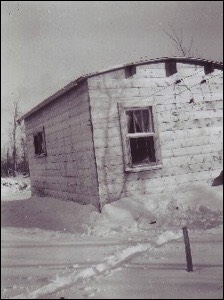
Our little cabin in the north
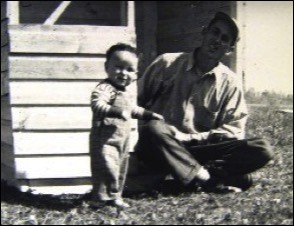
Warren (Doug) helping Daddy build an outhouse
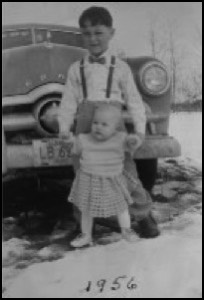
Warren (Doug) with baby sister Sylvia
Frank Greenfield eventually found Eva Foster and they traveled and enjoyed life until her passing in 2000. He then came to live and help me in my home (Doug / Warren) until we moved to the Sunshine Coast in 2003. Father enjoyed his own apartment here until January of 2007 when, because of health complications, he began the most difficult year of his life. This last year, spent in the Sechelt hospital and Totem Lodge for seniors, was a year of trauma and pain as he suffered from back pain, rectal cancer, another broken hip, a stroke and many falls. We were pleased that he could enjoy the last four months in the homelike cottage of Christensen Village in Gibsons. Father fought off his cancer but succumbed to pneumonia on April 21st. 2008
I appreciate my father for the fact that he was always there for us, even in later years. He was my hero becase he never dreamed of leaving us for booze or other women like some men do. He was our provider, our example, our strong advocate and we appreciated that he was loved and respected by everyone in the community.
For both Mother and Father we grieve deeply, but at the same time are able to celebrate lives that were lived well and the fact that they both had made peace with their Lord before they crossed the Jordan.
In September 2010 Frank and Marjorie came back to their beloved Peace River country and their ashes were officially buried at the Eaglesham cemetery. A dwindling group of pioneers along with dear friends and relatives attended the coming home ceremony.
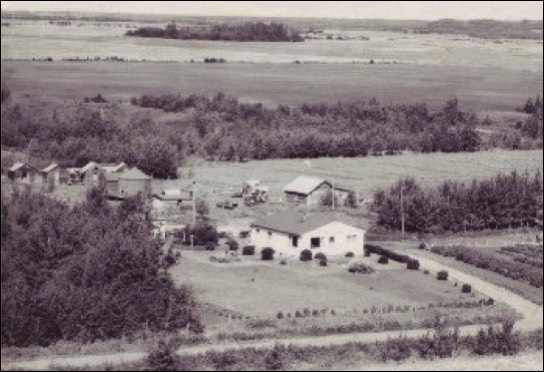
25 years of hard work led to the completion of this picturesque Greenfield farmstead in Northern Ablerta
This homestead provided a fabulous lifestyle, a secure business endeavour and a wonderful place for children to grow and learn.
Read more of the Life & Times of Frank and Marjorie Greenfield in the autobiography of Douglas Greenfield and family.
"Beyond The Homestead"
Contact the Greenfield Family:
Doug & Maggie Greenfield Box 266 Eaglesham Alberta T0H 1H0 780-359-2121
ObscureMyEmail
Web Design by: Artscript Canada Business Promotion
Along with Artscript Publications & Peace Country Authors and Writers these websites are business innovations of Doug and Maggie Greenfield
